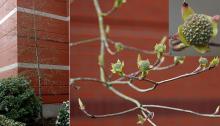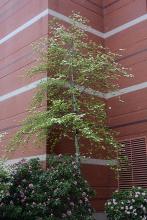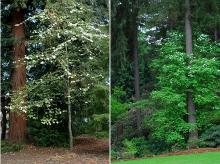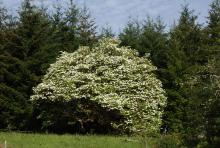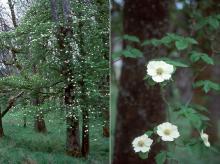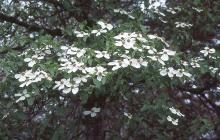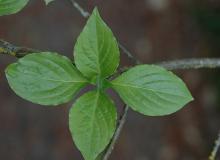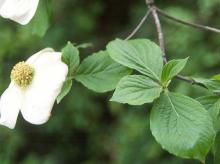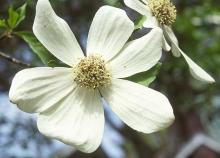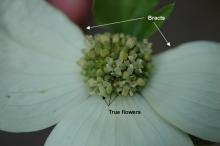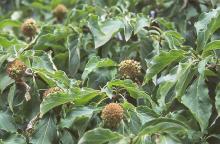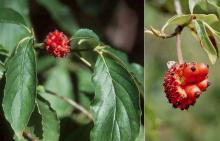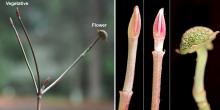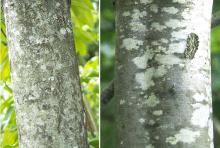Cornus nuttallii
Common name:
Pacific Dogwood
Western Dogwood
Pronunciation:
KOR-nus nu-TAL-e-i
Family:
Cornaceae
Genus:
Type:
Broadleaf
Native to (or naturalized in) Oregon:
Yes
- Broadleaf deciduous tree, 30-40 ft (9-12 m), upright (excurrent). Leaves opposite, clustered at the ends of branches, simple, elliptic-ovate to obovate, 7.5-13 cm long, wedge-shaped at the base, often a short point at the apex, 5-6 pairs of veins, petiole 6-15 mm long. Large flower buds at ends of stems. Inflorescence has 4-8 showy white, rarely pink, bracts (incorrectly, "petals"), 5-8 cm long, subtending the dense, more or less hemispherical, flower cluster, which contain some 30-40 small, dull green or purple flowers. Blooms in spring and occasionally repeats in fall. Fruit is a dense globular clusters, each about 1 cm long, orange to bright red in fall.
- If you are having trouble distinguishing Cornus nuttallii, Pacific Dogwood, from Cornus florida, Flowering Dogwood, you are in good company. David Douglas, the famous Scottish plant explorer, was the first botanist to observe the Pacific Dogwood but he mistook it for the Flowering Dogwood and did not send seeds back to England (Peattie, 1953).
- Part shade. Best in well-drained acid soils high in organic matter. Often does not do well in garden conditions. Bark damaged by hot sun. Sensitive to many stresses. Not suited to eastern U.S. climate.
- Hardy to USDA Zone 7 Native range extends along the Pacific coast, inland to about 200 miles, from just beyond Vancouver Island, British Columbia, to southern California. A disjunct population occurs in north-central Idaho.
- A few cultivars are available, including 'Colrigo Giant', 'Goldspot', and 'North Star'. A well known hybrid of C. florida × C. nuttallii is 'Eddie's White Wonder'.
- nuttallii: after Thomas Nuttall (1784-1859), English-American botanist and ornithologist. The name was given by John James Audubon (1785-1851), the great describer and painter of American birds, and a friend of Nuttall. Audubon writes that the plant is "a superb species of Dogwood, discovered by our learned friend Thomas Nuttall, Esq., when on a march towards the shores of the Pacific Ocean, and which I have graced with his name!" (Peattie, 1953).
- Oregon State Univ. campus: in the "arboretum" behind (south) of Moreland Hall.
Click image to enlarge

